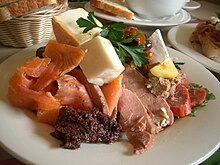Antipasto
This article includes a list of general references, but it lacks sufficient corresponding inline citations. (February 2013) |
 Antipasto served in a restaurant | |
| Place of origin | Italy |
|---|---|
| Main ingredients | Any of cured meats, olives, peperoncini, mushrooms, anchovies, artichoke hearts, cheese, pickled meats and vegetables (in oil or vinegar) |
| Variations | Seafood platter; calamari, mussels, smoked salmon, tuna fish, olives. |

Antipasto (plural antipasti) is the traditional first course of a formal Italian meal.[1] Typical ingredients of a traditional antipasto include cured meats, olives, peperoncini, mushrooms, anchovies, artichoke hearts, various cheeses (such as provolone or mozzarella), pickled meats, and vegetables in oil or vinegar.
The contents of an antipasto vary greatly according to regional cuisine. It is quite possible to find different preparations of saltwater fish and traditional southern cured meats (like soppressata or 'nduja) in the south of Italy, whereas in northern Italy it will contain different kinds of cured meats and mushrooms and, especially near lakes, preparations of freshwater fish. The cheeses included also vary significantly between regions and backgrounds, and include hard and soft cheeses.
Many compare antipasto to hors d'oeuvre, but antipasto is served at the table and signifies the official beginning of the Italian meal. It may also be referred to as a starter, or an appetizer.
See also
 Italy portal
Italy portal Food portal
Food portal- Cured meat
- List of ancient dishes and foods
- List of hors d'oeuvre
- List of Italian dishes
- Meze
- Tapas
- Zakuski
References
- ^ "Definition of ANTIPASTO". www.merriam-webster.com.
Further reading
- Scicolone, Michele (1998). The Antipasto Table. HarperCollins. ISBN 9780880016278. Retrieved April 20, 2012.
